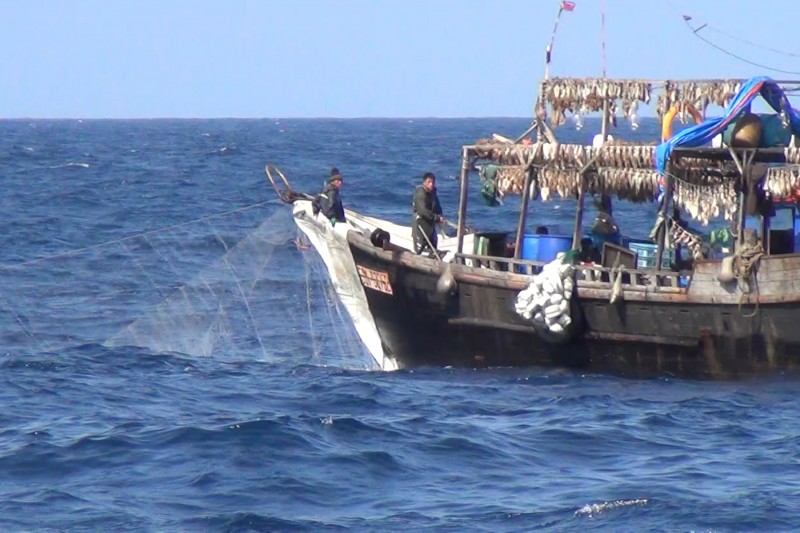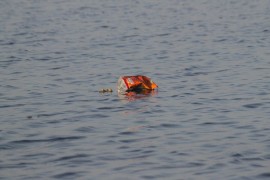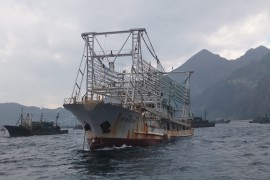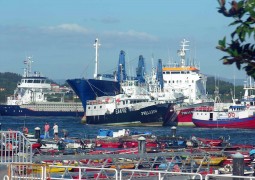
South Korean squid fishermen in the East Sea (Sea of Japan). (October, 2017).
THE OUTLAW OCEAN PROJECTEn CTXT podemos mantener nuestra radical independencia gracias a que las suscripciones suponen el 70% de los ingresos. No aceptamos “noticias” patrocinadas y apenas tenemos publicidad. Si puedes apoyarnos desde 3 euros mensuales, suscribete aquí
The battered wooden “ghost boats” drift through the Sea of Japan for months, their only cargo the corpses of starved North Korean fishermen whose bodies have been reduced to skeletons. Last year more than 150 of these macabre vessels washed ashore in Japan, and there have been more than 500 in the past five years.
For years the grisly phenomenon mystified Japanese police, whose best guess was that climate change pushed the squid population further from North Korea, driving the country’s desperate fishermen dangerous distances from shore, where they become stranded and die from exposure.
But an investigation conducted by an international team of academic researchers, Ian Urbina a former New York Times investigative reporter who now directs The Outlaw Ocean Project, and Global Fishing Watch, a non-profit organization that specializes in the use of satellite technology and Artificial Intelligence to track illegal activities on the high seas, based on new satellite data has revealed what marine researchers now say is a more likely explanation: China is sending a previously invisible armada of industrial boats to illegally fish in North Korean waters, violently displacing smaller North Korean boats and spearheading a decline in once-abundant squid stocks of more than 70 percent.
The Chinese vessels — nearly 800 in 2019— appear to be in violation of U.N. sanctions that forbid foreign fishing in North Korean waters. The sanctions, imposed in 2017 in response to the country’s nuclear tests, were intended to punish North Korea by not allowing it to sell fishing rights in its waters in exchange for valuable foreign currency.
“This is the largest known case of illegal fishing perpetrated by a single industrial fleet operating in another nation’s waters,” said Jaeyoon Park, a data scientist from Global Fishing Watch.
China is a member of the U.N. Security Council, which unanimously signed the recent North Korean sanctions. But the flotilla violating this ban comprises nearly a third of the entire Chinese distant-water fishing fleet, according to Global Fishing Watch.
Last year more than 50 bodies of North Koreans washed onto Japanese beaches, according to the Japanese Coast Guard
Presented with the findings of the investigation, the Chinese Ministry of Foreign Affairs said that, “China has consistently and conscientiously enforced the resolutions of the Security Council relating to North Korea.” The ministry added that China has “consistently punished” illegal fishing.
In March, two countries anonymously complained in a report to the United Nations about China’s violations of these sanctions and they provided evidence of the crimes, including satellite imagery of the Chinese ships fishing in North Korean waters and testimony from Chinese fishing crew who said they had alerted their government of their plans to fish in North Korean waters.
The fishing grounds in the Sea of Japan, known in the Koreas as the East Sea, are located between the Koreas, Japan and Russia, and include some of the world’s most contested and poorly monitored waters. Up to now, the huge presence of Chinese boats in this area was largely hidden, because their captains routinely turn off their transponders, making them invisible to on-land authorities, which under most conditions is illegal.
Global Fishing Watch and its partner researchers were able to document these vessels, however, using several types of satellite technology, including one that spots bright lights at night. Many squid boats use extremely strong lights to draw their prey nearer to the ocean surface, making the squid easier to catch. The Chinese also use what are called “pair trawlers,” which consist of two side-by-side boats with a net strung between them that combs the seas, which are easier to track by satellite since the two travel together.
So many North Koreans have disappeared at sea in recent years that some North Korean port towns, including Chongjin along the country’s eastern shore, are now called “widows villages.” Last year more than 50 bodies of North Koreans washed onto Japanese beaches, according to the Japanese Coast Guard.
The grim uptick of these ghost boats washing ashore has stoked paranoia and inflamed a tense history between Japan and North Korea, leading some in Japan to speculate that the ghost boats are carrying spies, thieves, or possibly even weaponized carriers of contagious disease.
“If a Korean ship lost its way, it would be destroyed by the time it lands on our beaches,” said Kazuhiro Araki, CEO of the Abduction Research Organization, a group that studies the history of hundreds of Japanese citizens who were allegedly kidnapped by North Korea in the 70s and 80s. “But some ships arrived to our coast intact, and with no men on board, and its possible those people are spies who made it to land.”
Encrusted with shells and algae, these flat-bottom wooden boats are 15 to 20 feet long and typically carry five to 10 men. They have no toilets or beds, just small jugs of clean water, fishing nets and tackle, according to Japanese Coast Guard investigation reports. They fly tattered North Korean flags and their hulls are often emblazoned with painted numbers or markings in Korean script including, "State Security Department" and "Korean People's Army."
All of the bodies found on board these ghost boats appear to be male, though some were so badly decomposed that Japanese investigators struggled to say for sure. Political tensions between the countries and a lack of transparency in the so-called “Hermit State” of North Korea make it difficult to get an official explanation of the phenomenon.
In 2004, China signed a multi-million-dollar fishing license agreement with North Korea that led to a drastic increase in the number of Chinese boats in North Korean waters. But international sanctions imposed in 2017 in response to North Korea's intercontinental ballistic missile launches and nuclear tests were meant to squeeze key sources of North Korean revenue.
A long-time benefactor of North Korea, China signed the sanctions after being pressured by the United States, and in August 2017 China’s minister of commerce publicly reiterated his government’s commitment to enforce these new rules.
Seafood remains North Korea's sixth-biggest export and in recent speeches the country’s dictator, Kim Jong Un, has pushed the state-owned seafood industry to increase its haul.
"Fish are like bullets and artillery shells," an editorial in the Rodong Sinmun, the official newspaper of the ruling Workers' Party of Korea, said in 2017. "Fishing boats are like warships, protecting the people and the motherland."
In the wake of the U.N. sanctions and as foreign currency reserves have dwindled, the North Korean government has tried to bolster its fishing industry by turning soldiers into fishermen, dispatching these poorly-trained seafarers onto notoriously turbulent waters. The sanctions have also intensified North Korea’s gasoline shortage. Japanese investigators say that some of the Korean fishing boats washing onto Japanese beaches suffered from engine failure or simply ran out of fuel.
Since 2013, at least 50 survivors have been rescued from these dilapidated boats, but in interviews with Japanese police, the men rarely say more than that they were stranded at sea and that they want to be returned home to North Korea. Autopsies on the bodies found on these boats usually indicate that the men starved or died from hypothermia or dehydration.
In 2013, North Korean fishermen were limited by the capacity of their 12-horsepower engines and they typically only traveled several dozen miles from land, said a former North Korean fisherman, who defected to South Korea in 2016 and now lives in Seoul.
“Government pressure is greater now, and there are 38-horsepower engines,” said the defector, who asked to remain anonymous for fear of repercussions for his family. “People are more desperate, and they can go farther from shore.”
But marine researchers say that pressure from the North Korean government is not the only factor.
“Competition from the industrial Chinese trawlers is likely displacing the North Korean fishers, pushing them into neighboring Russian waters,” said Jungsam Lee, whose institute also found hundreds of North Korean vessels fished illegally in Russian waters in 2018.
In 2017, the Japanese Coast Guard also reported spotting more than 2,000 North Korean fishing boats fishing illegally in their waters. In more than 300 instances, the Japanese Coast Guard used water cannons to force these boats to leave the area.
*****
Around the globe, many kinds of fish and sea creatures are disappearing at an unsustainable rate due to climate change, overfishing and illegal fishing by industrial fleets. As these fishing stocks shrink, competition grows and offshore clashes between fishing nations become more common. Seafood-loving countries like Japan and South Korea are being edged out by growing fleets from Taiwan, Vietnam and most of all, China.
In 2017, the Japanese Coast Guard also reported spotting more than 2,000 North Korean fishing boats fishing illegally in their waters
With a population of over 1.38 billion, China is the world's biggest consumer of seafood and its global catches have grown by over 20 percent in the past five years. Many of the fishing stocks closest to China’s shores have collapsed from overfishing and industrialization, which is why the Chinese government heavily subsidizes its fishermen, who sail the world in search of new grounds.
Fishing fleets from China accounted for 50 to 70 percent of the squid caught on the high seas in recent years, according to an estimate by the Chinese government. Often these boats are fishing illegally in other countries’ national waters, according to analysis by C4ADS, a marine research firm.
The Sea of Japan includes disputed patches of water where the surrounding countries — Russia, Japan and the two Koreas — do not recognize each other’s sea borders. The incursion of the Chinese in this region has only intensified local tensions.
Chinese fishing boats are famously aggressive, often armed and known for ramming competitors or foreign patrol vessels. Chinese media often depict the country’s maritime clashes with other nearby Asian nations as an extension of ancient China's Three Kingdoms, which fought a fierce three-way battle for supremacy.
Tensions between Seoul and Beijing increased in 2016 after a Chinese vessel, illegally fishing in South Korean waters, sank a South Korean Coast Guard cutter. The cutter was in South Korean waters and was trying to stop a Chinese fishing ship that allegedly had been caught illegally fishing when another Chinese ship rear-ended the marine officers.
Similarly, while reporting at sea for this investigation, reporters for this article filmed 10 of these illegal Chinese fishing ships crossing into North Korean waters. However, the reporting team was forced to divert its course to avoid a dangerous collision after one of the Chinese fishing captains suddenly swerved toward the team’s boat, coming within 10 meters, likely intending to ward off the boat.
Spotted at night and roughly 100 miles from shore, the Chinese squid ships would not respond to radio calls and were traveling with their transponders off.
A yearly migratory species, the so-called Pacific Flying Squid spawn in waters near the southeastern port city of Busan or off South Korea's southernmost island of Jeju. They swim north in the spring before returning south to their birthplace between July and September.
In 2017 and 2018, the illegal Chinese boats, which are typically about 10 times larger than North Korean boats, caught as much of the squid as Japan and South Korea combined — an estimated 160,000 tons, worth more than $440 million annually.
Marine researchers fear a full collapse of this squid colony, which has declined by 63 percent and 78 percent in South Korean and Japanese waters respectively since 2003.
The Chinese fleet is a primary culprit of this precipitous drop because in targeting North Korea waters, these industrial boats are catching the squid before they grow big enough to procreate, said Park, the scientist from Global Fishing Watch.
Since Chinese authorities do not make their fishing licenses public, Global Fishing Watch said that there is no way to verify that all of the ships entering North Korean waters were authorized by the Chinese government. However, the organization corroborated that the vessels were of Chinese origin through various other sources of information.
Among these corroborating sources were transponder and other types of radio transmissions, records from South Korean Coast Guard officials who routinely board and inspect fishing ships on their way into North Korean waters, data showing the ships departed from Chinese ports or waters that are strictly limited Chinese vessels, records indicating the use of distinctly Chinese gear type or ship design, and satellite information showing that the ships previously fished in Chinese waters that are closely policed and forbidden to foreign ships.
All of the roughly two dozen fishing ships that the reporting team witnessed heading into North Korean waters were flying Chinese flags.
“When they come, they take over,” said Kim Byong Su, the mayor of Ulleung island, located in the East Sea about 75 miles east of the Korean Peninsula. A tiny spit of land belonging to South Korea, Ulleung is the closest port to the North Korean fishing grounds.
Kim said that the Chinese squid boats have decimated the island’s two primary sources of income, tourism and fishing. In the Jeodong market near the pier, rows of the squid are draped across lines like folded laundry as they sun-dry into fish jerky. Squid sellers estimated that the per-pound cost of squid is roughly three times what it was less than five years ago.
Most of the island’s men older than 40 are squid fishermen but a third of them are now unemployed because of the decline in stock, the mayor said. That a creature so central to the local culture could disappear has shaken this community, whose identity has been defined by squid fishing for centuries.
Historically, most of the Ulleung’s restaurants served fried, dried or raw squid as a free appetizer, but these dishes are now absent from many menus.
Local animosity toward the Chinese fleet has been made only worse, the mayor said, because a few times a year when bad weather strikes, an armada of more than 200 Chinese squid boats arrive simultaneously to the Ulleung’s port to ride out the storm. The mayor said he is powerless to tell them to leave.
They dump oil, throw litter, run loud smoky generators all night and when leaving drag their anchors, destroying the island’s freshwater pipes, he said.
“The outside world needs to know what’s happening here”, Mr. Kim said.
The battered wooden “ghost boats” drift through the Sea of Japan for months, their only cargo the corpses of starved North Korean fishermen whose bodies have been reduced to skeletons. Last year more than 150 of these macabre vessels washed ashore in Japan, and there have been more than 500 in the past five...
Autor >
Ian Urbina
Ian Urbina es exreportero de investigación del New York Times y director de The Outlaw Ocean Project, una organización de periodismo sin fines de lucro con sede en Washington, D.C., que se enfoca en informar sobre crímenes ambientales y de derechos humanos en el mar.
Suscríbete a CTXT
Orgullosas
de llegar tarde
a las últimas noticias
Gracias a tu suscripción podemos ejercer un periodismo público y en libertad.
¿Quieres suscribirte a CTXT por solo 6 euros al mes? Pulsa aquí







